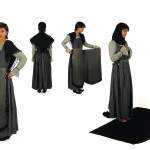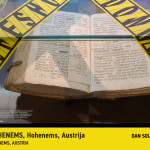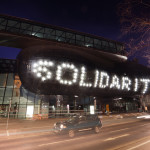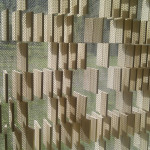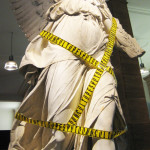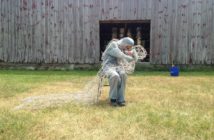Azra Akšamija is a Sarajevo born artist and architectural historian and, currently, Assistant Professor in the Visual Arts at MIT’s Art, Culture and Technology Program. In her interdisciplinary practice, Akšamija investigates the ways that art and architecture can facilitate the process of transformative mediation in cultural and political conflicts. In doing so, she provides a framework for researching, analyzing, and intervening in contested socio-political realities.
I caught up with Azra after her excellent talk about her wearable mosques at the TransCultural Exchange Conference. She was kind enough to sit down with me and we discussed a number of topics ranging from the relationship between art and politics to the function of architecture on a body scale to the future.
Michael Zachary One of the things that struck me about your talk is that you seem to propose a very inclusive definition of architecture. Are there a lot of people who wonder how you got from your training in architecture to making wearables?
Azra Akšamija For me architecture is a very broadly defined term. As I was studying, I realized how many things could be included in that term. One of those things was the scale of the body, the body as architecture. I looked at textile structures as something you would apply to architecture as a support system, but also as architecture themselves. I also got interested in textiles for the way you make the fabric, the way the patterns can, from a certain perspective, reflect memory and cultural practices. The politics of the material and its history. There is so much richness to something that we consider to be a pure fabric. It is supposedly so simple, but actually there are all these different things you can read from it.
MZ Such as?
AA The history of a certain people, technologies that they have developed and the way that affects the economy of a certain region (perhaps with global implications), the way you can trace exchanges between different groups that happen through textiles. If you look at the history of cotton or wool, for instance, you quickly get into colonial histories. That is one fascination. The other is of course different cultural conflicts that are carried out on the one hand in the public space of culture, and on the other hand in those more personal realms that most significantly expressing one’s identity. In my work specifically that I presented at this conference, those spaces would be religious architecture and clothing that stands for one’s personal identity but also one’s group belonging.
MZ It sounds like you are treating both architecture and clothing as texts in a way, texts that encodes a large body of cultural information some of which is overt and some of which is covert. A wonderfully poetic term you used in your talk comes to mind: "calligraphy on a body scale".
AA Exactly. I look at art and architecture and also text, the way architecture can also be understood as a way of inscribing land. If you look at the way people build religious buildings, beyond being a place of worship and community it is also a way of inscribing the history of a certain community, and that architecture binds that history to certain territories. In a way buildings are inscriptions on the land, and clothing is inscription on our bodies.
MZ Which makes the shift in practice from architecture to clothing particularly interesting, because clothing is much less permanent, much more ephemeral than inscribing on the landscape. Do you feel like the temporary and changeable nature of wearables and textiles allows you to talk about certain things in a way architecture perhaps could not?
AA I chose fashion in the case of the mosque issue because I wanted to address on the one hand that was happening in a large community and shrink it, to bring it back to a human scale, to something people could affiliate themselves with. If you have a piece of clothing and I like it, I can see myself in it and maybe it is something I can relate to more easily than a piece of a building that is more or less representative of a collective entity. That is one thing and the other was really about bringing in humanness and individuality; wearables allowed me to talk about single individuals within a group, each of which who may be very unique and diverse.
MZ That reminds me of the way you used the term "elastic scriptural definition" in your talk, describing the way a text is adapted in a different way by each individual according to his or her circumstances.
AA That’s true. The generative design principles (for what a mosque is) that I presented at the conference are a way of capturing that elasticity in terms of conceptual regulations. If you respect these conceptual regulations formally you can then play much more within them. For example, you can choose a textile for water and have it be water and a mosque at the same time. Anything can become a material for a mosque if you respect these cultural parameters and then the form can be quite playful.
MZ That touches directly on something I have been thinking about in your work, which is the relationship between functionality and symbolism in these objects. Do you feel like that is a tension in the work, and if so how does it function?
AA There is certainly a tension, but I play with this purposely. I need the functionality in order to make the argument that this could be a mosque. I need to prove visually and functionally that this could become one if one is using it as such. But that is not the main purpose of this work, the actual functionality of these pieces is to function as a provocation for a different type of dialog, to provoke thoughts, to provoke different kinds of discussions, to shift debate which is very often hostile in a more friendly and constructive direction. The question really is "How is this a mosque?" and then "What is a mosque?" and then people want to know more and that provokes a learning process. Where it becomes problematic is if only one reading of these is taken. For example once I was presenting at a political party event where people were not familiar with contemporary art and the different ways you could read it, so the took it as a purely functional proposal, that we should not build mosques now, we should just make them and wear them. That becomes problematic of course because of all the public functions of mosques that are not accommodated in this space (of the wearables). I think the context in which the work is presented is important, so that is why it always has me present to mediate these conversations and explain things. I call these boundary objects; they lend themselves to different interpretations. It’s a piece of fashion. It’s also a holy object. It’s also a personal thing. It’s a mosque but also an educational device. It’s a conversation starter, a visual argument. It has all these different layers in it, and that is exactly the tension but also the potential in this kind of piece.
MZ Do you feel like these objects have a life of their own beyond your intentions? Has there ever come a moment when one of these objects took on meaning and purpose for someone in ways you didn’t mediate or intend?
AA Not that much. It might happen if this became a product, if some people were interested in buying or producing these wearable mosques. In that sense if it did not have me in the equation to lead the discussions then I think it would take on a life of it’s own. But I do think there is something about the way that these pieces are designed that there is an agency to the design itself. Often in exhibitions I show it as just a piece of clothing on a clothing rack and there is no conversation. It communicates just by being itself. That is not something I can control fully. From the perspective of a designer you can anticipate some of that and allow it to happen. I think that is one of the afterlives of this project, to start thinking about a series of these or how they would multiply without me present.
MZ And is there a transformative ambition in this work? I’m thinking here of a very long history of magical objects that allow the wearer to take on a different persona in both artistic and spiritual practice.
AA There certainly is. I want to have it be a model for empowering people, particularly young Muslim women, to speak out and talk about identity, to show who they are without fear. There are so many issues in play for young Muslim women after September 11, particularly for these young women who are recognized as Muslim because they are wearing veils but also within their own communities where you have negotiations going on between different generations, different genders. That is why this piece speaks quite often to young Muslim women. It’s not something that addresses, say, an old Egyptian grandmother. Because it talks about these issues that young people are going through. Also, because of the way that I talk when I am in it and I transform into this kind of mosque person, a kind of transformation happens of course of myself but also of the dialog and hopefully of the perception of Islamic spaces. So yes, the ambition is there but how far that works I haven’t been able to fully assess yet.
MZ Talking about the elephant in the room now, what is the role of politics in your art? What role should politics play in art?
AA We are always affected by politics, and political conflicts are often the trigger for art. That is one of the reasons why I started doing this work. But there is difference between art and the actual political realm of governance. I think they are interconnected and they inform each other. But there is also difference between them. Ideally . . . I don’t want to make general statements for all artists . . . but ideally I try to mix things not only to the extent that I create art about politics but also to actually have a kind of intervention; to create, regardless of how small it might be, some form of transformation in a political process and to actually also do politics with artistic rhetoric. There are limits to that rhetoric of course. I’m not going to change the American Constitution or the Bosnian Constitution or whatever, and that is also not my goal. My goal is to take steps to educate, raise awareness about certain issues, discuss and also help you build up consciousness of your own, of your environment, and of others. That will hopefully then inform thinking and engagement. This is the realm in which I am working.
Sometimes the activist part of my work is very difficult to differentiate. Recently I organized a platform called "culture shut down" that connected artists, activists, museum people, historians, and other people working on the problems of cultural institutions in Bosnia-Herzegovina that are shutting down due to political problems. I co-founded this platform and then organized a global day of solidarity, which was a major global action. I called on representatives of museums and galleries worldwide to express solidarity with the threatened Bosnian institutions by participating in a collective action: crossing out one work in their collection with a yellow barricade tape that I sent them. This was in March this year. It was an artwork, but it was also a kind of global protest and a way of lobbying. So it was a kind of intertwined thing.
MZ So then what are you interested in and thinking about right now, and for the future? More global actions?
 Azra Aksamija, Solidarity Day Postcard, 2013. Jewish Museum Hohenems participation in CULTURESHUTDOWN (a project initiated by Azra Aksamija).
Azra Aksamija, Solidarity Day Postcard, 2013. Jewish Museum Hohenems participation in CULTURESHUTDOWN (a project initiated by Azra Aksamija).AA The future is actually exactly what I am thinking about. Just bigger questions really. What is heritage? How do we define ourselves at present, and our past, and also our future? Why does that matter? Who decides? How do we negotiate that, and at what point in history have we started caring about that? Right now I am working on a project called "Future Heritage Collection" that collects stories from people that are really about iconoclasm, and about a kind of value and meaning of objects and the potential they have as a memory but also in terms of their design and their relevance for the future. So this is one of the things I am currently working on. The other doesn’t have much to do with art, but it has to do with heritage. It has to do with how you move from the protected space of academia and actually do something, really achieve a transformation so that is a thing I hope to be doing with my culture shutdown platform and the projects I have been doing with it. And the third thing that I am currently starting to think about again is going back to Bosnia and returning to the research that I did for my PhD, which was about the systematic destruction of architecture in the war and how that has effected not only the quest for identity by Bosnian Muslims but also the future of coexistence in Bosnia. So I am going back a little to that trauma that my whole society and also I have been through. These are the three things that currently occupy me.
MZ I think that is a beautiful and poignant moment to end on, perched halfway between the past and the future. I’ll let you have the last word Azra.
AA Maybe just . . . I’m always curious why people do what they do. And why do they think it is important. I mean… I pose it more as a question, also to you. Many people decide to work on things just because they think they can get a better job or earn some money, but as an artist you are really taking quite a risky shot. And yet there is still in many artists such an urge to continue doing it. Part of it often has something to do with ego, but part is really to try to contribute to society and the world we live in. For me this doesn’t necessarily have to be through art so I see these things as much more fluid, as some form of creative work: architecture, clothing, writing… I don’t really care actually. It depends on the topic and the issue that is at stake, and then what medium best communicates that to the audience.
Ok. I’ll stop here.
- Azra Aksamija, Inside View Southeast. Investigations on Backyard Mosques.
- Azra Aksamija, Solidarity Day Postcard, 2013. Jewish Museum Hohenems participation in CULTURESHUTDOWN (a project initiated by Azra Aksamija).
- Azra Aksamija, Museum Solidarity Day, 2013. Kunsthaus Graz (P. Cook + C. Fournier, 2003), Austria, participating in the global Museum Solidarity Day organized by Aksamija, March 2013. Photo: J.J. Kucek / Kunsthaus Graz, UMJ.
- Azra Aksamija, Wearable Mosques. Installation view, 2013. Photo by Laura Anca Chichisan.
- Azra Aksamija, Shingle-Mihrab, 2012. Qibla wall and prayer rugs at the Islamic Cemetery in Altach. Mixed media: stainless steel mesh curtains, wooden shingles, new wool handwoven carpets (flat-weave).(LF).
- Azra Aksamija, Solidarity Day Postcard, 2013. German Historical Museum participation in CULTURESHUTDOWN (a project initiated by Azra Aksamija).




